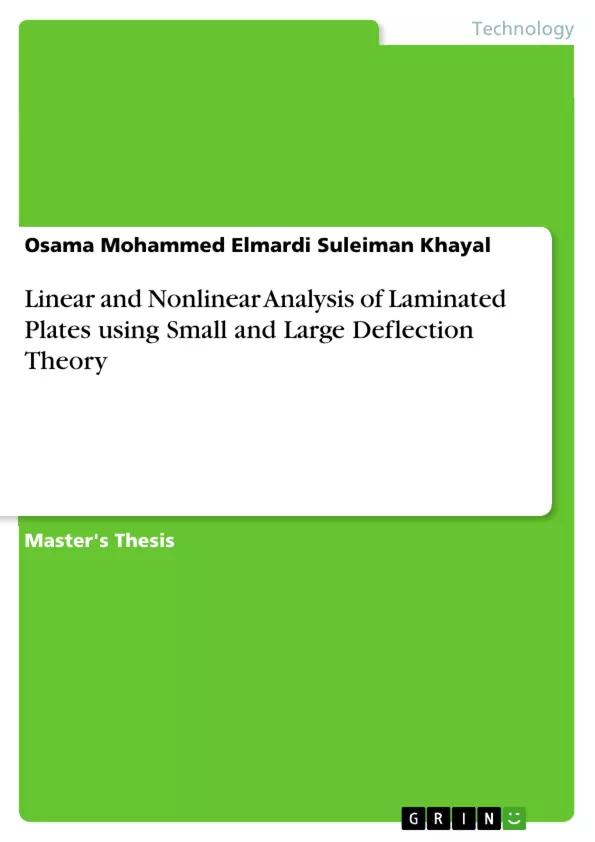The objective of this book is to present a complete and up to date treatment of rectangular laminated plates with uniform cross sections. Dynamic Relaxation (DR) method is presented for the geometrically linear and nonlinear laterally loaded, rectangular laminated plates. The analysis uses the Mindlin plate theory which accounts for transverse shear deformation. A computer program has been compiled. The convergence and accuracy of the DR solutions for elastic small and large deflection response are established by comparison with various exact and approximate solutions.
New numerical results are generated for uniformly loaded square laminated plates which serve to quantify the effects of shear deformation, material anisotropy, fiber orientation, and coupling between bending and stretching. It was found that linear analysis seriously over-predicts deflections of plates. The shear deflection depends greatly on a number of factors such as length/ thickness ratio, degree of anisotropy and number of layers. It was also found that coupling between bending and stretching can increase or decrease the bending stiffness of a laminate depending on whether it is positive or negative.
Inhaltsverzeichnis (Table of Contents)
- Introduction
- Scope of the Work
- Objectives and Motivation
- Literature Review
- Theoretical Formulation
- Mindlin Plate Theory
- Stress-Strain Relations
- Equilibrium Equations
- Boundary Conditions
- Numerical Solution Technique
- Dynamic Relaxation (DR) Method
- Discretization and Finite Difference Scheme
- Solution Procedure
- Convergence Criteria
- Numerical Results and Discussion
- Validation of the DR Solution
- Effect of Shear Deformation
- Effect of Material Anisotropy
- Effect of Fiber Orientation
- Effect of Coupling between Bending and Stretching
Zielsetzung und Themenschwerpunkte (Objectives and Key Themes)
The main objective of this work is to develop a numerical method for analyzing the nonlinear behavior of rectangular laminated plates subjected to transverse loads. The study employs the Mindlin plate theory, which accounts for shear deformation, and utilizes the Dynamic Relaxation (DR) method for solving the governing equations.
- Nonlinear behavior of laminated plates
- Shear deformation effects
- Material anisotropy
- Fiber orientation influence
- Coupling between bending and stretching
Zusammenfassung der Kapitel (Chapter Summaries)
- Introduction: This chapter introduces the scope and objectives of the research, providing a background on the importance of understanding the nonlinear behavior of laminated plates. It also outlines the key themes and motivations behind the study.
- Theoretical Formulation: This chapter presents the theoretical foundation of the analysis, including the Mindlin plate theory, stress-strain relations, equilibrium equations, and boundary conditions. It lays the groundwork for the numerical solution method.
- Numerical Solution Technique: This chapter focuses on the Dynamic Relaxation (DR) method, a numerical technique used to solve the governing equations. It describes the discretization process, finite difference scheme, solution procedure, and convergence criteria.
- Numerical Results and Discussion: This chapter presents the results obtained using the DR method, demonstrating the validity of the solution by comparing it with existing analytical and numerical solutions. It then analyzes the effects of shear deformation, material anisotropy, fiber orientation, and coupling between bending and stretching on the plate's behavior.
Schlüsselwörter (Keywords)
The main keywords and focus topics of this work are: laminated plates, nonlinear analysis, Mindlin plate theory, Dynamic Relaxation (DR) method, shear deformation, material anisotropy, fiber orientation, bending-stretching coupling, numerical modeling.
- Citar trabajo
- Osama Mohammed Elmardi Suleiman Khayal (Autor), 2003, Linear and Nonlinear Analysis of Laminated Plates using Small and Large Deflection Theory, Múnich, GRIN Verlag, https://www.grin.com/document/464045



